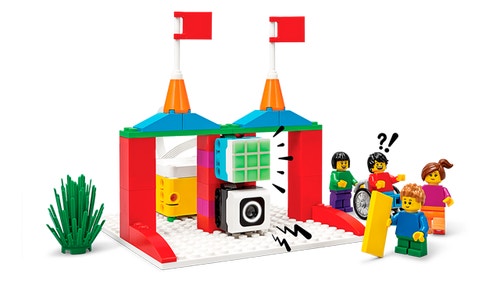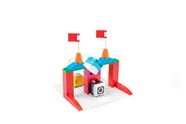The Fast Lane
Help Leo enter the amusement park through the Fast Lane!

Prepare
- Review the Fast Lane lesson in the LEGO® Education SPIKE™ App.
- If you feel that it would be beneficial, pre-teach these related vocabulary words: brainstorm, build, challenge, create, program and upgrade.
- Consider the abilities and backgrounds of all your pupils. Differentiate the lesson to make it accessible to everyone. Please refer to the Differentiation section below for suggestions on how to do this.
- If time permits, plan and facilitate the language arts extension. Please refer to the Extension section below for further information.
Engage
(Whole Class, 5 Minutes)
- Facilitate a quick discussion about brainstorming.
- Talk with your pupils about going to an amusement park and seeing a long queue at the entrance.
- Ask questions like these: What could you do to make it more fun to stand in the queue? How could you avoid standing in that long queue?
- Introduce your pupils to the story’s main characters and the first challenge: switching on the Fast Lane’s light.
- Distribute a brick set and a device to each group.
Explore
(Small Groups, 30 Minutes)
- Have your pupils use the LEGO® Education SPIKE™ App to guide them through their first challenge:
- Create and test the program that switches on the light when Leo shows his yellow ticket to the Colour Sensor.
- Have your pupils iterate and test their models to complete the next two challenges in the app:
- Program the Fast Lane to react differently when Leo shows his yellow ticket to the Colour Sensor.
- Upgrade the Fast Lane for Leo.
- You can find coding and building help in the Tips section below.
Explain
(Whole Class, 5 Minutes)
- Gather your pupils together to reflect on their completed challenges.
- Ask questions like these: What did you do for Leo? How did you upgrade the Fast Lane?
Elaborate
(Whole Class, 5 Minutes)
- Prompt your pupils to discuss and reflect on how brainstorming helped them to think of ways to upgrade the Fast Lane.
- Ask questions like these: How did you come up with ideas for upgrading the Fast Lane? Why do you think it is important to come up with more than one idea?
- Have your pupils tidy up their workstations.
Evaluate
(Ongoing Throughout the Lesson)
- Ask guiding questions to encourage your pupils to ‘think aloud’ and explain their thought processes and reasoning in the decisions they have made while building and programming their models.
Observation Checklist
- Measure your pupils’ proficiency in brainstorming new ideas.
- Establish a scale that suits your needs. For example:
- Requires additional support
- Can work independently
- Can teach others
Self-Assessment
Have each pupil choose the brick that they feel best represents their performance.
- Yellow: I think that I can brainstorm new ideas.
- Blue: I can brainstorm new ideas.
- Green: I can brainstorm new ideas, and I can also help a friend to do
it.
Peer Feedback
- In their small groups, have your pupils discuss their experiences working together.
- Encourage them to use statements like these:
- I liked it when you…
- I would like to hear more about how you…
Tips
Coding Tips
- After your pupils have completed their first challenge, they will be provided with a map.
- Using the map, your pupils can experiment with the available Coding Blocks to modify their programs to follow the route for the trip.




Model Tip
- After your pupils have completed their second challenge, they will be provided with three Inspiration Images and an open-ended prompt, which will help them to improve their models.
- The Inspiration Images are meant to help spark their imaginations as they experiment and change their models.




There are no specific building instructions for this challenge.
Differentiation
Simplify this lesson by:
- Shortening the lesson to include only the first challenge
- Selecting one Inspiration Image to help your pupils to change their models
Increase the difficulty by:
- Adding different Colour Sensor Blocks to the Programming Canvas to react to different-coloured tickets
- Exploring new and different Coding Blocks in the program
Extension
- Have your pupils create videos of different things Leo can do while he is waiting in the queue to enter the amusement park.
If facilitated, this will extend beyond the 45-minute lesson.
Language Arts: ACELA1444
Understand that language is used in combination with other means of communication, for example facial expressions and gestures to interact with others.
Teacher Support
The pupils will:
- Practise brainstorming in order to generate ideas
- Practise helping a story character
- Describe key ideas or details from a text
(one for every two pupils)
- LEGO® Education SPIKE™ Essential Set
- Device with the LEGO® Education SPIKE™ App installed
Design and Technologies
ACTDEP005
Explore needs or opportunities for designing, and the technologies needed to realise designed solutions.
Digital Technologies
ACTDIP004
Follow, describe, and represent a sequence of steps and decisions (algorithms) needed to solve simple problems.
English Language
ACELA1444
Understand that language is used in combination with other means of communication, for example facial expressions and gestures to interact with others.




